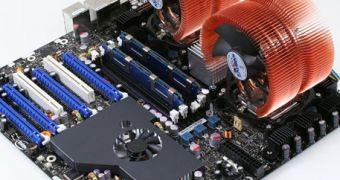The Xeon platform, although extremely powerful and overclockable, has been kept off the consumers' hands for 10 years now. It was about time that Intel released a consumer-oriented alternative based on the powerful Xeons, and the 10th Xeon anniversary will bring us the Skulltrail beast in all its splendor.
Skulltrail is a strange kind of platform, comprised of an Intel D5400XS motherboard and a pair of LGA771 quad-core Xeons that have undergone some significant tweaks. The manufacturer had them rebranded as Core 2 Extreme QX9775, since the Xeon name would make the user associate it with those expensive servers.
The Skulltrail platform basically inherits all the important aspects of the Xeon technology, but at the same time, they are different in some key points. The Xeon X5482s are fully interchangeable with the Core 2 Extreme QX9775 chips and are based on the same socket LGA 771, rather than the usual LGA775 for desktop systems. Moreover, both processors have the same four cores running at 3.2GHz, 12MB of L2 cache (6MB divided per two cores) and a 400MHz (1,600MHz effective) front side bus.
At the same time, while the Xeons are optimized for pre-fetching workstation/server applications such as database functionality, the QX9775 are tweaked for gaming and multimedia computing. Moreover, the Core 2 Extreme name shows that the processor comes with an unlocked multiplier, that comes in handy for those who are planning to overclock a lot. Based on the Penryn 45-nanometer architecture, both Xeon X5482 and Core 2 Extreme QX9775 CPUs are energy-efficient and feature low thermal envelopes.
The Intel D5400XS motherboard is built around the Intel 5400 chipset that also powers new Xeon motherboards (such as the SuperMicro X7DAW-N, for instance). The bad thing about this chipset is that you will be forced to feed it the expensive and slower 800MHz PC2-6400 FBDIMM memory, since DDR2 or DDR3 modules are not supported.
The good side is that the D5400XS is extremely expandable. It provides four 16x PCI-E 1.1 slots and two PCI slots. The chipset is also fully compatible with the PCI-Express 2.0 standard, but Intel rigged the four graphics expansion slots with Nvidia's nForce 100 chips, the cornerstone of the SLI technology. CrossFire is also supported, so it's up to you whether you pick Nvidia or AMD to power your display(s).
The board's PCB has been reshaped in order to allow enthusiasts use LGA 775 cooling solutions, since the LGA 771 offering is extremely poor and cheap. The fans, however, must be positioned in a way that would allow them to blow cold air over both FBDIMMs and the Northbridge.
The motherboard also comes with RAID-capable S-ATA II ports, plus a pair of eSATA ports that allows users to connect external storage devices. The board also features 10 USB 2.0 ports, two FireWire connectors and a single EIDE port for older optical drives.

 14 DAY TRIAL //
14 DAY TRIAL //